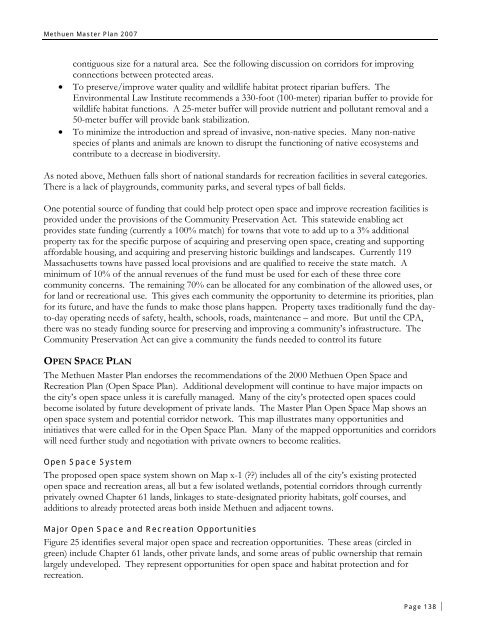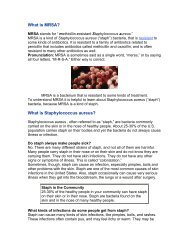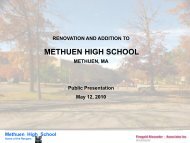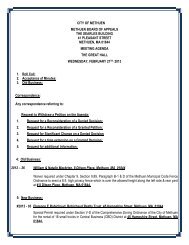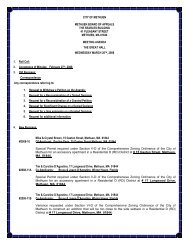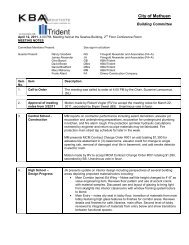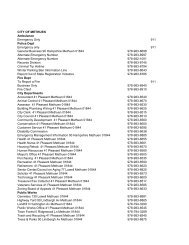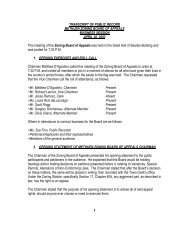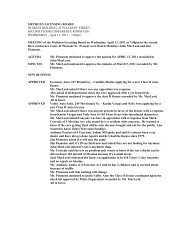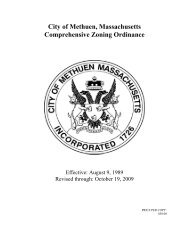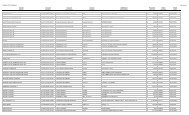City of Methuen Master Plan
City of Methuen Master Plan
City of Methuen Master Plan
Create successful ePaper yourself
Turn your PDF publications into a flip-book with our unique Google optimized e-Paper software.
<strong>Methuen</strong> <strong>Master</strong> <strong>Plan</strong> 2007<br />
contiguous size for a natural area. See the following discussion on corridors for improving<br />
connections between protected areas.<br />
• To preserve/improve water quality and wildlife habitat protect riparian buffers. The<br />
Environmental Law Institute recommends a 330-foot (100-meter) riparian buffer to provide for<br />
wildlife habitat functions. A 25-meter buffer will provide nutrient and pollutant removal and a<br />
50-meter buffer will provide bank stabilization.<br />
• To minimize the introduction and spread <strong>of</strong> invasive, non-native species. Many non-native<br />
species <strong>of</strong> plants and animals are known to disrupt the functioning <strong>of</strong> native ecosystems and<br />
contribute to a decrease in biodiversity.<br />
As noted above, <strong>Methuen</strong> falls short <strong>of</strong> national standards for recreation facilities in several categories.<br />
There is a lack <strong>of</strong> playgrounds, community parks, and several types <strong>of</strong> ball fields.<br />
One potential source <strong>of</strong> funding that could help protect open space and improve recreation facilities is<br />
provided under the provisions <strong>of</strong> the Community Preservation Act. This statewide enabling act<br />
provides state funding (currently a 100% match) for towns that vote to add up to a 3% additional<br />
property tax for the specific purpose <strong>of</strong> acquiring and preserving open space, creating and supporting<br />
affordable housing, and acquiring and preserving historic buildings and landscapes. Currently 119<br />
Massachusetts towns have passed local provisions and are qualified to receive the state match. A<br />
minimum <strong>of</strong> 10% <strong>of</strong> the annual revenues <strong>of</strong> the fund must be used for each <strong>of</strong> these three core<br />
community concerns. The remaining 70% can be allocated for any combination <strong>of</strong> the allowed uses, or<br />
for land or recreational use. This gives each community the opportunity to determine its priorities, plan<br />
for its future, and have the funds to make those plans happen. Property taxes traditionally fund the dayto-day<br />
operating needs <strong>of</strong> safety, health, schools, roads, maintenance – and more. But until the CPA,<br />
there was no steady funding source for preserving and improving a community’s infrastructure. The<br />
Community Preservation Act can give a community the funds needed to control its future<br />
OPEN SPACE PLAN<br />
The <strong>Methuen</strong> <strong>Master</strong> <strong>Plan</strong> endorses the recommendations <strong>of</strong> the 2000 <strong>Methuen</strong> Open Space and<br />
Recreation <strong>Plan</strong> (Open Space <strong>Plan</strong>). Additional development will continue to have major impacts on<br />
the city’s open space unless it is carefully managed. Many <strong>of</strong> the city’s protected open spaces could<br />
become isolated by future development <strong>of</strong> private lands. The <strong>Master</strong> <strong>Plan</strong> Open Space Map shows an<br />
open space system and potential corridor network. This map illustrates many opportunities and<br />
initiatives that were called for in the Open Space <strong>Plan</strong>. Many <strong>of</strong> the mapped opportunities and corridors<br />
will need further study and negotiation with private owners to become realities.<br />
Open Space System<br />
The proposed open space system shown on Map x-1 (??) includes all <strong>of</strong> the city’s existing protected<br />
open space and recreation areas, all but a few isolated wetlands, potential corridors through currently<br />
privately owned Chapter 61 lands, linkages to state-designated priority habitats, golf courses, and<br />
additions to already protected areas both inside <strong>Methuen</strong> and adjacent towns.<br />
Major Open Space and Recreation Opportunities<br />
Figure 25 identifies several major open space and recreation opportunities. These areas (circled in<br />
green) include Chapter 61 lands, other private lands, and some areas <strong>of</strong> public ownership that remain<br />
largely undeveloped. They represent opportunities for open space and habitat protection and for<br />
recreation.<br />
Page 138


